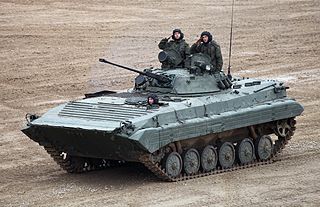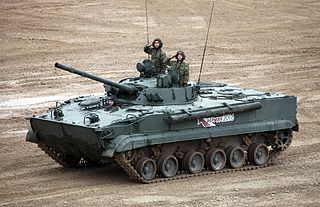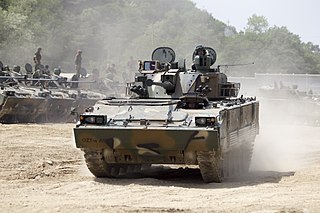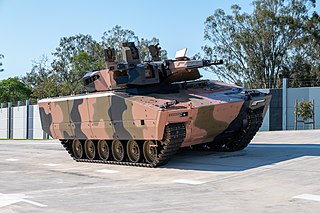 W
WThe AIFV is a US tracked light armored vehicle that serves as an infantry fighting vehicle (IFV) in the armies of several countries. It is a development of the M113A1 armored personnel carrier.
 W
WThe AMX-10P is a French amphibious infantry fighting vehicle. It was developed after 1965 to replace the AMX-VCI in service with the mechanized regiments of the French Army; the first prototypes were completed in 1968. Production commenced between 1972 and 1973.
 W
WThe "Armata" Universal Combat Platform is a Russian advanced next generation modular heavy military tracked vehicle platform. The Armata platform is the basis of the T-14, the T-15, a combat engineering vehicle, an armoured recovery vehicle, a heavy armoured personnel carrier, a tank support combat vehicle and several types of self-propelled artillery, including the 2S35 Koalitsiya-SV under the same codename based on the same chassis. It is also intended to serve as the basis for artillery, air defense, and NBC defense systems. The new "Armata" tank platform is meant to replace the older Russian MBTs and APCs that are currently used by the Russian military.
 W
WThe BMD-1 is a Soviet airborne amphibious tracked infantry fighting vehicle, which was introduced in 1969 and first seen by the West in 1970. BMD stands for Boyevaya Mashina Desanta. It can be dropped by parachute and although it resembles the BMP-1 it is in fact much smaller. The BMD-1 was used as an IFV by the Soviet Army's airborne divisions. An improved variant of the BMD-1 was developed, the BMD-2. The BMD-1 also provided a basis for the BTR-D airborne multi-purpose tracked APC.
 W
WThe BMD-3 is an infantry fighting vehicle (IFV) originating from the former Soviet Union. This armored fighting vehicle is one of the lightest in its class and is intended to be a fire support platform for use by airborne and air assault units. The primary armament is a 30 mm 2A42 autocannon capable of firing different types of ammunition which include high-explosive and armor-piecing. The BMD-3 possesses multiple secondary weapons such as the 9M113 Konkurs missile and the AGS-17 grenade launcher to defeat a wide range of targets from enemy infantry to other armored fighting vehicles.
 W
WThe BMD-4 is an amphibious infantry fighting vehicle (IFV) originating from post-Cold War Russia. Originally designated as the BMD-3M, the chassis of the BMD-4 is the same as that of the BMD-3, because it was developed on the same basis. This armored fighting vehicle is one of the lightest and one of the most heavily armed in its class, possessing a substantial amount of firepower in comparison to its counterparts. The vehicle was designed to transport Russian Airborne Troops (VDV); increasing its mobility, armament, and protection on the battlefield.
 W
WThe BMP-1 is a Soviet amphibious tracked infantry fighting vehicle. BMP stands for Boyevaya Mashina Pjehoty 1, meaning "infantry fighting vehicle, 1st serial model". The BMP-1 was the first mass-produced infantry fighting vehicle (IFV) of the Soviet Union. It was called the M-1967, BMP and BMP-76PB by NATO before its correct designation was known.
 W
WThe BMP-2 is a second-generation, amphibious infantry fighting vehicle introduced in the 1980s in the Soviet Union, following on from the BMP-1 of the 1960s.
 W
WThe BMP-3 is a Soviet and Russian infantry fighting vehicle, successor to the BMP-1 and BMP-2. The abbreviation BMP stands for boevaya mashina pehoty.
 W
WThe BMP-23 is a Bulgarian infantry fighting vehicle which was first introduced in the early 1980s. However, it was based on a design from the Bulgarian design bureau from the 1950s, being presented in 1960. Despite its name, the BMP-23 is very different from the BMP-1 and more similar in function to the BMP-2. The hull is based on that of the Soviet 2S1 self-propelled howitzer with thicker armour and a more powerful diesel engine, which is itself based on a stretched MT-LB chassis. Since the 2S1 is a larger vehicle, the troop transport compartment is not as cramped as that of the BMP-1. The armour is cast steel, capable of withstanding heavy machine gun fire. The turret is armed with a 23-mm autocannon 2A14 from the air-defence gun ZU-23-2 with 600 rounds, and initially an ATGM launcher for the 9M14 Malyutka, today with 9K111 Fagot ATGM.
 W
WThe BTR-T is a Russian heavy infantry combat vehicle, designed by the Design Bureau of Transport Machine-Building (Omsktransmash) state-run production association.
 W
WThe BVP M-80, is a tracked Yugoslavian-made infantry fighting vehicle, produced from the 1980s until the country's collapse in the 1990s.
 W
WThe Combat Vehicle 90 is a family of Swedish tracked combat vehicles designed by Sweden's Defense Materiel Administration , Hägglunds and Bofors during the mid-1980s to early 1990s, entering service in Sweden in the mid-1990s. The CV90 platform design has continuously evolved in steps from Mk0 to current MkIV with advances in technology and in response to changing battlefield requirements. The Swedish version of the main infantry fighting vehicle is fitted with a turret from Bofors that is equipped with a 40 mm Bofors autocannon. Export versions are fitted with Hägglunds E-series turrets, armed with either a 30 mm or a 35 mm Bushmaster autocannon.
 W
WThe Dardo is an infantry fighting vehicle designed for the Italian Army as a replacement for the M113 APC. It is designed and built by the Iveco Fiat Oto Melara Syndicated Company based in Rome. Iveco is responsible for the hull and propulsion systems, while Oto Melara is responsible for the weapons and fire control systems.
 W
WACV-15 is the designation of an amphibious armored combat vehicle family developed by the Turkish defense company FNSS Savunma Sistemleri A.Ş.. This vehicle is also manufactured by DRB-HICOM Defence Technologies (DefTech). The design is an attempt to combine the capabilities of an infantry fighting vehicle (IFV) and an armoured personnel carrier (APC). The ACV-15 is based on the American Advanced Infantry Fighting Vehicle, which in turn is based on the American M113A1 armored personnel carrier.
 W
WThe FV432 is the armoured personnel carrier variant in the British Army's FV430 series of armoured fighting vehicles. Since its introduction in the 1960s, it has been the most common variant, being used for transporting infantry on the battlefield. At its peak in the 1980s, almost 2,500 vehicles were in use.
 W
WThe K21 is a South Korean infantry fighting vehicle. A replacement for the K200-series, it was formerly designated as K300 or XK21 KNIFV. The initial production began in 2009, with the Republic of Korea Army planning to field approximately 466 units. It is designed to effectively defeat other IFVs as heavily armed and armored as the BMP-3.
 W
WThe K200 KIFV is a South Korean armoured personnel carrier, originally produced by Daewoo Heavy Industries as a domestic replacement for older armored personnel carriers, such as the M113, in front line service with the Republic of Korea Armed Forces at the time of the K200's development. Since 2009 the K200 has been supplemented by the K21. A total of 2,383 K200 vehicles of all configurations were produced between 1985 and 2006, among which are 111 K200A1 vehicles exported to Malaysia.
 W
WThe Kurganets-25 is a tracked, 25-ton modular infantry fighting vehicle and armored personnel carrier being developed for the Russian Army. The Kurganets-25 will evolve into various models, gradually replacing BMP, BMD, MT-LB and other types of tracked Soviet armored platforms. The Kurganets-25 will have modular armor that can be upgraded for specific threats.
 W
WThe LAZIKA is a proposed Georgian Infantry fighting vehicle, developed by the Scientific Technical Center STC Delta and funded by the Georgian military. One of its main characteristics is the relatively thick armor compared to the vehicle's size. Another feature is the remote weapon station. A number of vehicles has been produced, but the project itself is still under development with various versions including uparmored ones, being taken into consideration.
 W
WThe Lynx is a German armoured fighting vehicle developed by Rheinmetall Landsysteme. The Lynx, configured as a KF31 infantry fighting vehicle (IFV), was unveiled publicly at the Eurosatory defence exhibition on June 14, 2016. The KF41 variant was unveiled publicly at the Eurosatory defence exhibition on June 12, 2018. According to Rheinmetall, the Lynx family of tracked armoured vehicles is at the forefront of a new trend in IFV design toward armoured vehicles with lower unit and through-life costs and reduced complexity. One of the key principles of the Lynx concept is the integration of proven sub-systems with a high technology readiness level to reduce development time, cost and technical risk.
 W
WThe M2 Bradley, or Bradley IFV, is an American infantry fighting vehicle that is a member of the Bradley Fighting Vehicle family. It is manufactured by BAE Systems Land & Armaments, which was formerly United Defense.
 W
WThe M3 Bradley Cavalry Fighting Vehicle (CFV) is an American tracked armored reconnaissance vehicle manufactured by BAE Systems Land and Armaments. A member of the Bradley Fighting Vehicle family, the M3 CFV is used by heavy armored cavalry units in the United States Army.
 W
WThe Marder is a German infantry fighting vehicle operated by the German Army as the main weapon of the Panzergrenadiere from the 1970s through to the present day. Developed as part of the rebuilding of Germany's armoured fighting vehicle industry, the Marder has proven to be a successful and solid infantry fighting vehicle design. While it used to include a few unique features, such as a fully remote machine gun on the rear deck and gun ports on the sides for infantry to fire through, these features have been deleted or streamlined in later upgrade packages to bring it more in line with modern IFV design. It is overall a simple and conventional machine with one large rear exit hatch and three top hatches for mounted infantry to fire from. The Marder is currently being replaced by its successor, the Puma.
 W
WThe Mitsubishi Type 89 IFV (89 FV ) is a Japanese infantry fighting vehicle that entered service with the Japan Ground Self-Defense Force in 1989. There were 58 vehicles in service as of 1999 and a total of 120 produced by 2014 with 300 planned. The main armament of the vehicle is an Oerlikon Contraves 35 millimeter KDE cannon.
 W
WThe MLI-84 is a tracked Romanian infantry fighting vehicle currently in service with the Romanian Land Forces. It was derived from the chassis of the Soviet BMP-1 but possessing a lengthened hull, a 12.7×108mm DShK 1938/46 heavy machine gun mounted on the roof of the troop compartment and MLI-84M having Oerlikon KBA autocannon and new ATGMs.
 W
WThe Puma is a German infantry fighting vehicle (IFV) designed to replace the aging Marder IFVs currently in service with the German Army. Production of the first batch of 350 vehicles began in 2010 and is scheduled for completion by the third quarter of 2020. A second batch of 210 Pumas has received funding. Mass production began on 6 July 2009. The companies responsible for this project are Krauss-Maffei Wegmann and Rheinmetall Landsysteme, who created a joint venture in the form of Projekt System Management GmbH (PSM). The Puma is one of the world's best-protected IFVs, while still having a high power-to-weight ratio.
 W
WSchützenpanzer Lang HS.30, formally Schützenpanzer, lang, Typ 12-3, or SPz lg 12-3 for short, was a West German infantry fighting vehicle developed from 1956 to 1958. It was a Swiss Hispano-Suiza design, with a Rolls-Royce engine. After some early mechanical problems, only 2,176 were built of the 10,680 planned. It was armed with a 20-mm cannon, which was an unusually powerful weapon for an armoured personnel carrier of the period.
 W
WThe Sedena Henschel HWK-11 was a joint project between the Mexican Secretariat of National Defense (SEDENA) and Henschel Wehrtechnik GmbH of West Germany.
 W
WThe T-15 Armata, with industrial designation "Object 149", is a Russian heavy infantry fighting vehicle first seen in public in 2015 during rehearsals for the Moscow Victory Day Parade. The T-15 is expected to replace the BMP-2 and MT-LB based platforms of the Russian Ground Forces.
 W
WTulpar is a Turkish heavy infantry fighting vehicle designed by the Sakarya-based automotive manufacturer Otokar.It is named after the Tulpar, a winged horse in Turkic mythology.
 W
WThe Type 86, also known as WZ501, is a Chinese copy of the Russian BMP-1 infantry fighting vehicle (IFV).
 W
WThe T-64 is a Soviet second-generation main battle tank introduced in the early 1960s. It was a more advanced counterpart to the T-62: the T-64 served in tank divisions, while the T-62 supported infantry in motorized rifle divisions. It introduced a number of advanced features including composite armor, a compact engine and transmission, and a smoothbore 125-mm gun equipped with an autoloader to allow the crew to be reduced to three so the tank could be smaller and lighter. In spite of being armed and armored like a heavy tank, the T-64 weighed only 38 tonnes.
 W
WThe WPB Anders is a family of medium, tracked combat vehicles. The vehicle was designed by OBRUM part of the Bumar Group. It is named after Władysław Anders, a general of the Polish Army during World War II and later a member of the Polish government-in-exile.
 W
WThe ZBD-03 or Type 03 is a Chinese airborne infantry fighting vehicle. It features a light-weight chassis and hydropneumatic suspension for airborne operations. Early prototypes received the designation ZLC-2000.
 W
WThe ZBD-04 or Type 04 is a Chinese infantry fighting vehicle. It bears some external resemblance to the BMP-3, particularly with regards to its turret and main armament; however, the chassis and internal subsystem possesses a different layout. The earliest prototypes received the designation ZBD-97. An improved version, ZBD-04A, is the vehicle currently in service and being produced.